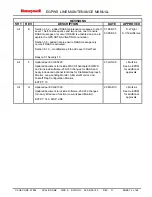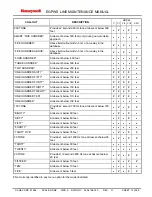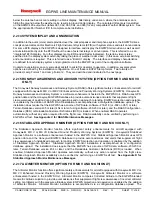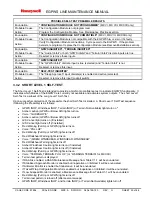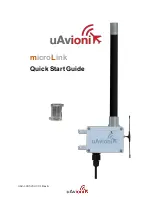
EGPWS LINE MAINTENANCE MANUAL
CAGE CODE: 97896
SCALE: NONE SIZE: A
DWG NO.: 060-4199-180
REV: G
SHEET 18 of 68
installation does require that the EGPWS has a source of GPS data, software -230-230 or later, Terrain Database
version 454 or later, and the Reloadable Customer Definitions (RCD) is loaded. When enabled, Altimeter Monitor
operates automatically, without any action required from the flight crew. Altimeter Monitor availability can be verified
by performing an EGPWS self test.
See Appendix E for Altimeter Monitor Maintenance Messages.
2.2.18 TAKEOFF FLAP CONFIGURATION MONITOR (OPTION FOR MK V AND MK VII
ONLY)
The Takeoff Flap Configuration Monitor function offers significant safety enhancements for aircraft equipped with
Honeywell’s MK V or MK VII Enhanced Ground Proximity Warning Systems (EGPWS). Honeywell’s Takeoff Flap
Configuration Monitor is a software enhancement hosted in the EGPWS Unit. Takeoff Flap Configuration Monitor
uses GPS position data, Flap angle inputs, and the Honeywell EGPWS Database to provide aural alerts that
supplement flight crew awareness of improper flap setting when the aircraft is aligned on a runway prior to takeoff.
EGPWS protection and operation is unaltered by the addition of Takeoff Flap Configuration Monitor. Takeoff Flap
Configuration Monitor installation is accomplished via a configuration database upload. The installation does
require that the EGPWS has a source of GPS data, flap angle input, software -230-230 or later, Terrain Database
version 454 or later, and the Reloadable Customer Definitions (RCD) is loaded. When enabled, Takeoff Flap
Configuration Monitor operates automatically, without any action required from the flight crew. Takeoff Flap
Configuration Monitor availability can be verified by performing an EGPWS self test.
See Appendix F for Takeoff
Flap Configuration Monitor Maintenance Messages.
2.2.19 LONG LANDING MONITOR (OPTION FOR MK V AND MK VII ONLY)
The Long Landing Monitor function offers significant safety enhancements for aircraft equipped with Honeywell’s MK
V or MK VII Enhanced Ground Proximity Warning Systems (EGPWS). Honeywell’s Long Landing Monitor is a
software enhancement hosted in the EGPWS Unit. Long Landing Monitor uses GPS position data and the
Honeywell EGPWS Database to provide aural alerts that supplement flight crew awareness of their position during a
landing when the aircraft has not touched down in a nominal amount of time and/or distance. EGPWS protection
and operation is unaltered by the addition of Long Landing Monitor. Long Landing Monitor installation is
accomplished via a configuration database upload. The installation does require that the EGPWS has a source of
GPS data, software -230-230 or later, Terrain Database version 454 or later, and the Reloadable Customer
Definitions (RCD) is loaded. When enabled, Long Landing Monitor operates automatically, without any action
required from the flight crew. Long Landing Monitor availability can be verified by performing an EGPWS self test.
See Appendix G for Long Landing Monitor Maintenance Messages.
2.2.20 LOW AIRSPEED MONITOR (MK V BOEING 737NG ONLY)
The Low Airspeed Monitor function offers significant safety enhancements for Boeing 737NG aircraft equipped with
Honeywell’s MK V Enhanced Ground Proximity Warning Systems (EGPWS). Honeywell’s Low Airspeed Monitor is
a software enhancement hosted in the EGPWS Unit. Low Airspeed Monitor uses Minimum Operating Speed and
Stick Shaker Speed input from the Stall Management and Yaw Damper computers to provide an aural alert that
supplements flight crew awareness that their airspeed had passes below 70% of the amber airspeed band.
EGPWS protection and operation is unaltered by the addition of Low Airspeed Monitor. Low Airspeed Monitor
installation is accomplished via an application software upload. The installation does require that the EGPWS has
software -232-232 or later loaded. When installed, Low Airspeed Monitor operates automatically, without any action
required from the flight crew. Low Airspeed Monitor availability can be verified by performing an EGPWS self test.
See Appendix H for Low Airspeed Monitor Maintenance Messages.

